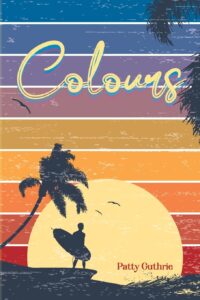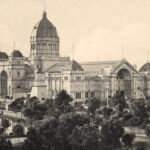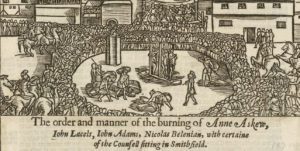“As a high school English teacher, I understand the importance of seeing yourself reflected in what you read and watch,” writes Patty Guthrie, in the author’s note of her debut young adult (YA) novel, Colours (Arkhouse Press, 2023).
There is a lot of great secular fiction out there written for, by and about the LGBTQ+ community, but while there are some theological books, I noticed there isn’t really any fiction, anything a teenager would (hopefully) be interested in.
Colours tells the story of Luke, the son of a Christian minister in Maroubra, Sydney, struggling to make sense of his sexual and romantic attraction to the new boy at his high school, Jamie. Luke faces the implications of these feelings for his friendships, family and belonging; his Christian faith and the trajectory of his adult life.
Completing, let alone publishing, a novel is an enormous achievement. Writing a novel which not only has good quality line-level writing, but also effective pacing, plotting, characterisation, thematic cohesion and so on, is even more of achievement. To attempt a novel on the topic of Christianity and homosexual desire is more ambitious still. On all of these levels and to a significant degree, Guthrie has been successful.
Whose Story to Tell? The Perils of Representation
I don’t think people should only ever write fiction from the perspective of their own age, class, sex, sexual orientation, health, time in history and religious beliefs.[1] But at the same time, there are legitimate frustrations that people feel when outsiders presume to talk about them and get it wrong; when stereotypes and tropes objectify them or reinforce simplistic or inaccurate perceptions about them. These frustrations are especially acute in those rare occurrences where art becomes financially successful, making a profit by telling the stories of other groups. Nevertheless, I believe that something can be problematic in some ways without it being nothing more than a problem. But it is definitely a tricky business.[2]
Guthrie’s protagonist is a teenage homosexual male; Guthrie is none of these things. Would a teenager take exception to her writing from their vantage point? Do I take exception to her writing a male protagonist? Perhaps I would feel differently if she drastically misrepresented the male experience; instead, I believe that overall, she portrays male experience, conversation and relationships in a way that resonates with my experience.[3] Still, it must be admitted, the novel is not about being male in the same way it is about being a Christian and experiencing homosexual desire.
Guthrie does not make it clear in her author’s note whether she employed ‘sensitivity readers’, but she does dedicate the novel, among others, to “my two gay friends with the initial K, who haven’t felt welcome in a church since they decided to embrace their sexuality freely and openly”. She also recommends several books by theological and ethically conservative same-sex attracted Christians. The influence of these friendships and books, along with other research, are evident in the pages of the novel itself.[4]
I could imagine some readers would prefer not to read the novel on these terms; no doubt some would find it objectionable, others might see it as veiled propaganda for a religious moral cause. I can appreciate both of those responses. But since the novel is marked by evident artistic merit and craftsmanship, sufficiently sophisticated characters and narrative complexity; and ends with sufficient open-endedness, I believe that however problematic it might be, it is much more than simply a problem.
Funny, Tender and at Times a Tearjerker

Colours contains a lot of lovely writing. I have written lots of ‘nice!’ and ‘naw!’ and ‘relatable’ and ‘lol’ in the margins of my copy. I’m a big fan of vivid settings and set pieces, and Guthrie delivers: sitting on the front lawn after dinner playing catch with the dog, an after-school trip to the beach, the first visit to the school’s Pride group, Luke dying his hair black, an outing to Newtown with friends.
Guthrie has a particular knack for describing emotional turmoil. One of several scenes I found deeply moving features a conversation Luke has with Jamie on the floor of a school bathroom, about Jamie’s mother, who recently died:
Jamie closed his eyes and tilted his head back, as if trying to let something trapped escape from his throat. “I just,” he began before his breath snagged.
He shook his head and tried again.
“When Miss asked us to write about someone we love, I started writing about my dad,” he said, looking at the ceiling.
He wrapped his arms around his knees, interlocking his fingers until the knuckles turned white.
“I started writing about him, and growing up and stuff” … His words came out all jumbled, trying to get the words out as quickly as possible before he couldn’t anymore. “You know, lucky that I got both my favourite foods and my favourite people.” …
His voice broke again and he looked away, rubbing angrily at his eyes.
“Yeah,” Luke forced himself to look down at his hands. “It must be hard, to lose your mum.”
“She was the best,” Jamie whispered, mostly to himself.
The novel’s description of the downward spiral into teen rebellion rang very true to my experience around this age.
In a scene where he discusses the school formal with his mum, Guthrie uses her skill to great effect in portraying Luke’s growing distress around his sexual orientation:
“I was thinking of going by myself,” he mumbled, then added, “or I might see if Jamie wants to go with me. We could go with Mikayla as a group.”
“A group of you?” It sounded like there were a few questions packed into one.
He could see the formal so clearly in his mind as his mum imagined it.
The picture had gone from a smiling Luke, in his new suit and tie, arm supporting some beauty teetering in her heels, to the three of them, awkwardly shoved in the back seat of a taxi together.
Suddenly, his two friends vanished and Luke pictured himself sitting alone.
“You sure there isn’t a nice girl in your class you could ask?”
The picture in Luke’s mind of him in his formal suit turned into one of him graduating university, alone.
This passage leads into one of the novel’s most anguished, pathetic and tender scenes. Luke rides away from his house on his bike in a thunderstorm, has an accident and appears on his best friend Mikayla’s doorstep.
Luke feels deep pain at the way he feels that homosexual attraction threatens his sense of belonging:
For his whole life, church had been the one place Luke had felt welcomed and known. The two feelings had gone hand in hand, almost without question. There were people within their church who had known him since he was a little boy. The church lawn had been his backyard, and he had become a part of the furniture. However, since meeting Jamie, something had changed. Suddenly, there was something to hide.
Guthrie peppers the book with some apt critique of church culture—the tendency to talk in terms of us vs them; the pain when church friends don’t check in on you when you stop attending regularly; the clumsy ways of handling difficult topics;[5] the hypocrisies and blind spots of confessing Christians.[6]
The belonging Luke experiences attending the Pride group provides a contrast to the alienation he is feeling at church:
He heard stories from people’s lives not dissimilar to his own, figuring out crushes and hurtful comments, navigating the school halls until they could get to the pride club on a Tuesday or find time to hang out with their friends. They felt like outcasts of society and its establishments, but that enforced independence was a badge of honour. … they had owned their exclusion, their isolation from the in crowd in a way Luke wasn’t sure he ever could.
The dialogue is, for the most part, very strong; as are the brief summaries of sermons and descriptions of informal Christian conversation between both adults and teenagers, churchgoers and unbelievers.
Guthrie does not just move the reader with her descriptions of turmoil and disillusionment, she also writes of apology, reconciliation and comfort with equal force. The believable interactions she recounts do a wonderful job of showing the otherworldly glory of repentance, forgiveness and acceptance.
The novel’s study of identity moves beyond the simplistic—refusing to reduce someone to their Christian faith or their sexual orientation: “[Your feelings] are a big part of what makes you who you are, but they are not all of who you are.” Even at its denouement, much remains open.
Weaknesses
There are some weaknesses in the novel. Colours is published by Arkhouse Press, an Australian publisher that offers what is called ‘hybrid publishing’.[7] The novel bears what I suspect to be some of the marks of its origins: some ambiguities, redundancies and unevenness in the writing, along with some minor errors. As the story moved into its immersive second act, however, I was distracted by these issues less and less.
I found the second act to be far more compelling than the first. I think this is partly because of more exposition and over-writing early on. It is also because, as the plot heats up, Guthrie’s flair for intense emotion is increasingly on display.
While largely very believable, there were times when the dialogue jarred. The number of Christian characters who gradually surrounded Luke—almost all of whom, it should be said, served the story wonderfully—seemed a little too coincidental. The timeline for Luke’s crisis and rebellion would have been more plausible if events had extended across months rather than weeks. A scene where Luke talks to God in an empty church building and a scene portraying his absolute nadir both veered into familiar melodramatic tropes. The latter also felt too rushed.
Although remaining wisely open-ended in some respects, the third act wrapped things up rather neatly in others: there were multiple reconciliations, a sports victory, a baptism. As someone who is not a regular reader of contemporary YA, I wondered if this was a convention of the category. Moreover, while noticing the convergence of happily-ever-afters, I must admit I was also thoroughly enjoying them. We should be allowed to have nice things sometimes, shouldn’t we?
Theological Ethical Questions
For those seeking a clear presentation of biblical ethics, there are some interesting tensions in this novel. Readers alert to the discussion around the relevance of the concept of ‘concupiscence’ to sexual ethics will notice its absence here.[8] The descriptor ‘gay Christian’, which many Christians consider unhelpful, is used both within the novel and the author’s note. The author’s note also creates curious ambiguities. It is clear from the books Guthrie recommends and the story she tells, that the author holds a conservative Christian sexual ethic. However, she writes:
I do not want to invalidate the story of Christians who do pursue relationships, but to try and do the theological footwork of what that means for Christians, and in particular young gay Christians, was not the purpose of this novel.
It’s possible that she chose to be somewhat circumspect to make this novel accessible to as many readers as possible. More questionable, in my mind, is the choice to list QLife alongside Kids Helpline and Lifeline at the end of the author’s note. I suspect that QLife might not be supportive of the faith of a Christian seeking help who wants to abstain for homosexual sex and romance because of that faith.
Colours is not best read and recommended as a discipleship nor as an evangelistic tool to justify or convince anybody of the Christian sexual ethic. It was not written to function that way. Instead, as Guthrie explains:
I just wanted to explore whether someone can even be attracted to the same sex and be saved (the answer, I hope is clear, is yes) and how the church can interact with those Christians (the answer, I hope is clear, is better). I wanted a character with gay and queer friends, and Christians who love and accept him. I wanted him to have awkward conversations with people that ended well, and to know that he is loved by God first and foremost.[9]
The theological ethics commended in the novel are of a subtle and exploratory kind. For those interested in that exploration, and appreciative of the genre of YA fiction, Colours would be worth a look.
Furthermore, YA fans (whether teens or the significantly older shadow YA readership!) who are simply looking for their next quick read (the novel is only about 160 pages long), might consider this a worthy contender.
[1] And even when they do, they cannot presume to speak for everybody in their demographic.
[2] Alex Chee suggests writers ask three questions before writing about other people groups: 1. “Why do you want to write from this character’s point of view?”; 2. “Do you read writers from this community currently?”; 3. “Why do you want to tell this story?” “How to Unlearn Everything When it comes to writing the ‘other’, what questions are we not asking?”. Vulture. 30th October 2019. https://www.vulture.com/2019/10/author-alexander-chee-on-his-advice-to-writers.html
[3] Her general skill in portraying male characters, makes the occasional misstep. For example this reads like a woman writing about a man: “He had thought about mixing things up a million times, saying what his sister Ellie must be saying to his mum right now … But, as with many unspoken rules, Luke could feel an invisible line there, not to be crossed.”
[4] In the novel, characters tell the stories of Gilbert Baker and Bayard Rustin.
[5] “Of course, if you do have any questions about some of the things we do or don’t talk about tonight, please feel free to come and talk to one of us on the ministry team”, says Simon, the student minister, in a clumsy sermon on the topic of sexual immorality. Luke’s internal monologue wryly observes: “They always did that. They made it so that you had to come and talk to them, which no one was ever brave enough to do.” And afterwards: “Simon had continuously referred to it as ‘same sex-attraction’ or SSA, which sounded like some sort of disease.”
[6] “A few years ago, someone had brought wrist bands to youth group with the acronym W.W.J.D. embroidered on them – what would Jesus do? Apparently, he had heard years later, those bracelets were the most commonly stolen item from Christian bookstores, something Jesus would definitely not do.”
[7] Hybrid publishing provides the credibility of a publishing house platform, along with design work, printing and distribution. In this model, the author is usually responsible for a large part of the various levels of editing, typesetting and layout, and marketing. This is an entrepreneurial middle-ground between traditional publishing and indie publishing (self-publishing). But this leaves the author with some difficult work to do themselves, or expensive work to get done for them.
[8] “As I said, there is nothing wrong with those feelings. … There is nothing sinful about temptation alone – Jesus himself was tempted. It is what you do with those feelings that matters.”
[9] From a character in the novel itself: “That’s what you do from here. You love God and love others. Every morning, I wake up and I have to make the decision for myself. Sometimes it’s more than every morning, it’s every few hours. You just wake up and decide that you are going to follow Jesus that day. The rest follows.”
















